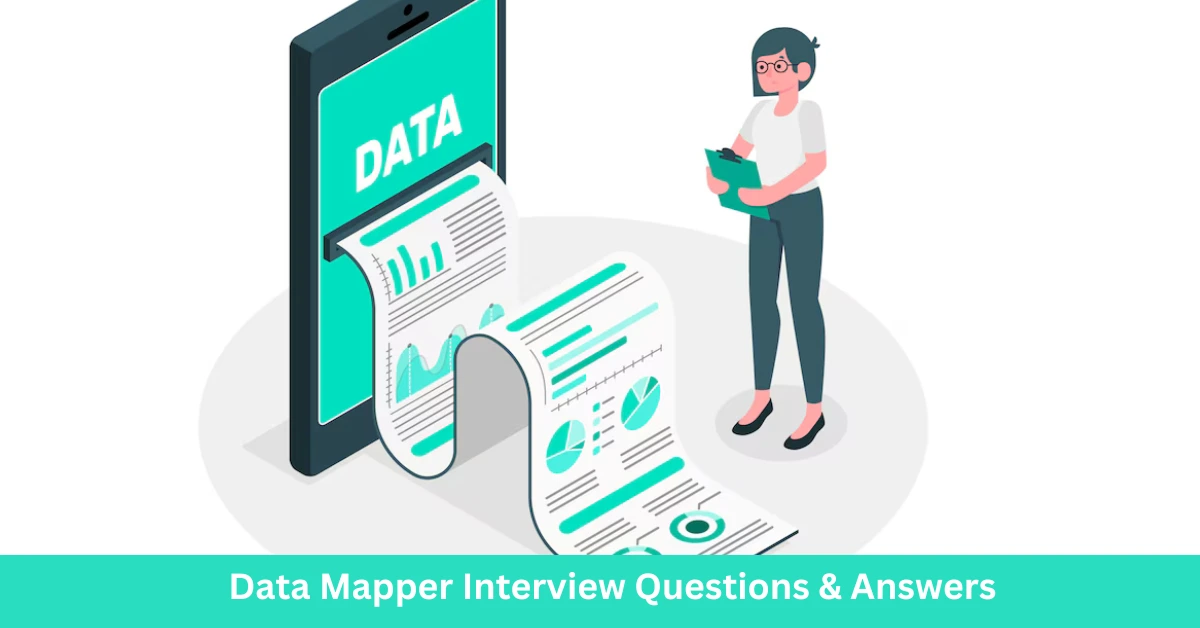Data mapping is a critical process in data integration and transformation, ensuring that data from different sources is accurately aligned and ready for analysis or migration. If you’re preparing for an interview for a Data Mapper role, understanding the technical and business aspects of data mapping is essential. Here are the top 15 data mapper interview questions and answers to help you land the job.
15 Data Mapper Interview Questions & Answers
Here’s a comprehensive list of 15 Data Mapper Interview Questions & Answers along with detailed answers to help you prepare and impress your interviewers.
1. What is data mapping, and why is it important?
Answer:
Data mapping is the process of connecting fields from one data source to another to ensure compatibility during data integration or migration. It is essential for maintaining data consistency, integrity, and usability across systems, such as during ETL (Extract, Transform, Load) processes.
2. What tools have you used for data mapping?
Answer:
I’ve worked with tools like:
3. Can you explain the difference between schema mapping and field mapping?
Answer:
- Schema mapping aligns the overall structure of one dataset with another, including tables and relationships.
- Field mapping matches individual fields or attributes within those tables to ensure compatibility.
Related Article: Top 15 Map Maker Interview Questions & Answers
4. What are some challenges in data mapping, and how do you overcome them?
Answer:
Challenges include:
- Inconsistent data formats: Use transformation rules to standardize data.
- Missing or incomplete data: Implement data validation checks.
- Complex source structures: Leverage automated tools to simplify mapping.
5. What is an ETL process, and how does data mapping fit into it?
Answer:
ETL (Extract, Transform, Load) involves extracting data from sources, transforming it for compatibility, and loading it into a destination system. Data mapping defines how source data is transformed and aligned with the target structure.
Related Article: Top 15 Field Map Editor Interview Questions & Answers
6. What steps do you take to validate your data mappings?
Answer:
To validate data mappings, I:
- Verify field-to-field matches and transformations.
- Run test migrations with sample data.
- Check for data integrity and consistency post-migration.
- Use automated validation tools where possible.
7. How do you handle data from multiple sources with different formats?
Answer:
I normalize the data by applying transformation rules, such as converting formats, aggregating values, and using lookup tables to resolve discrepancies.
Related Article: Top 15 Mapper Interview Questions & Answers
8. What is the role of metadata in data mapping?
Answer:
Metadata provides details about the data, such as field names, data types, and relationships. It is essential for understanding source and target structures and ensuring accurate mapping.
9. What is the difference between manual and automated data mapping?
Answer:
- Manual data mapping involves creating mappings manually, which is time-consuming but offers complete control.
- Automated data mapping uses tools or AI to create mappings faster, reducing errors but requiring validation.
Related Article: Top 15 LIDAR Technician Interview Questions & Answers
10. How do you approach mapping hierarchical or nested data structures?
Answer:
I use tools that support hierarchical data, such as JSON or XML parsers, to break down the structure into manageable components and map them to corresponding fields in the target system.
11. What is data transformation, and how does it relate to data mapping?
Answer:
Data transformation modifies data to fit the target format, such as changing date formats or combining fields. It is a key step in data mapping, ensuring source data aligns with target requirements.
Related Article: Top 15 Cartography Technician Interview Questions and Answers
12. How do you ensure scalability in your data mapping process?
Answer:
I ensure scalability by:
- Designing reusable mapping templates.
- Using modular and parameterized workflows.
- Leveraging cloud-based tools for handling large datasets.
13. What is a lookup table, and how is it used in data mapping?
Answer:
A lookup table contains reference data that helps map fields with non-matching values between source and target systems, such as translating country codes or product IDs.
14. How do you document your data mapping process?
Answer:
I document the process by:
- Creating a mapping specification document.
- Including details like source and target fields, transformation rules, and validation steps.
- Using version control for updates.
Related Article: Top 15 Cadastral Mapper Interview Questions
15. Can you give an example of a successful data mapping project you worked on?
Answer:
In a past project, I successfully migrated customer data from a legacy CRM to Salesforce. I used ETL tools to map and transform over 50 fields, ensuring data accuracy and maintaining relationships between records.
Conclusion
A Data Mapper plays a critical role in data migration and integration projects, ensuring data integrity and usability. Reviewing these top 15 Data Mapper Interview questions and answers will help you showcase your technical expertise and problem-solving skills in interviews.
Stay tuned to our blog for more tips on advancing your career in data management and integration.

1 thought on “Top 15 Data Mapper Interview Questions & Answers”